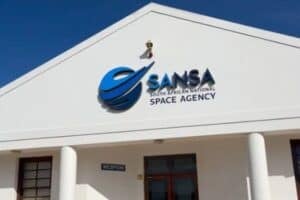The discovery proves organic materials from space may have played a role in the creation of life as we know it.

An international team of scientists have been researching the organic molecules found on the Asteroid Ryugu and their findings support the theory that the molecules are the building blocks for terrestrial life.
Ryugu is described in the team’s research paper[1] as “a dark, primitive asteroid C-type asteroid“, a common type found on the asteroid belt.
Alien life on Ryugu
The components – which are needed to create life – were collected from the Asteroid Ryugu’s surface by Japan’s Hayabusa2 spacecraft back in 2019.
WATCH: Asteroid Ryugu a ‘treasure box’
Hayabusa2 is led by the Japan Aerospace Exploration Agency (JAXA) in collaboration with the German Space Center (DLR) and the French Space Agency (CNES) and is supported by NASA and the Australian Space Agency (ASA).
The samples were delivered to Earth on 6 December 2020, and analysed by the research teams from Japan, NASA‘s Goddard Institute and Europe.
Building blocks of life
In a statement released by NASA last week, the researchers describe the findings as a “box of treasure from Asteroid Ryugu”, containing hydrogen, oxygen, nitrogen, sulfur, and other atoms.
The lead author of the research paper, Hiroshi Naraoka of Kyushu University in Fukuoka, Japan, said the “uppermost surface grains of Ryugu has the potential to protect organic molecules”.
This means the presence of prebiotic molecules on the asteroid’s surface could support the creation of life, despite Ryugu’s harsh environment of ultraviolet irradiation and solar heating.

In addition, cosmic-ray irradiation in the high-vacuum conditions of outer space would make the process of creating life particularly hard. nevertheless, it was possible on Ryugu.
PHOTO: One image, a billion galaxies! This is the largest map of the universe to date
Spreading throughout the Universe
Furthermore, Hiroshi Naraoka adds: “These molecules can be transported throughout the solar system, potentially dispersing as interplanetary dust particles after being ejected from the uppermost layer of the asteroid by impacts or other causes”.
Meanwhile, NASA’s Goddard Space Flight Center co-author, Jason Dworkin, said: “So far, the amino acid results from Ryugu are mostly consistent with what has been seen in certain types of carbon-rich meteorites that have been exposed to the most water in space”.

However, “sugars and nucleobases [which are the components of DNA and RNA] have been discovered in some carbon-rich meteorites and have not yet been identified in samples returned from Ryugu,” NASA co-author Daniel Glavin said.
ALSO READ: Tetrataenite: Scientists recreate alien substance found in outer space
Asteroid Ryugu: Other findings
In August 2022, researchers say ancient grains of dust found on Ryugu are older than our solar system itself.[2]
Some of the chemical compounds found on the space rock, such as silicon carbide, don’t occur naturally on Earth.
Earlier this year, scientists also found trace amounts of water in sample collected from Ryugu, lending credence to the speculation that life on Earth as we know it originated in outer space.[3]
References:
[1] Soluble organic molecules in samples of the carbonaceous asteroid (162173) Ryugu; Hiroshi Naraoka; Yoshinori Naraoka, Yoshinori Takano, Jason P Dworking, Yasuhiro Oba, Yuichi Tsuda and others, American Association for the Advancement of Science, Vol 379, Issue 66; 24 February 2023.
[2] Presolar Stardust in Asteroid Ryugu; Jens Barosch, Larry R Nittler, Jianhua Wang, Colen M. O’D Alexander, Bradley T De Gregorio, Cecile Engrand, Yoko Kebukawa and others; The Astrophysical Journal, Volume 935, Number 1; August 2022.
[3] Samples returned from the asteroid Ryugu are similar to Ivuna-type carbonaceous meteorites; Tetsuya Yokoyama, Kazuhide Nagashima, Izumi Nakai, Edward D Young, Yoshinare Abe, Jerome Aleon, Colen M O’D Alexander, Sachiko Amari, and others; American Association for the Advancement of Science, Vol 379, Issue 6634; 9 June 2022.






